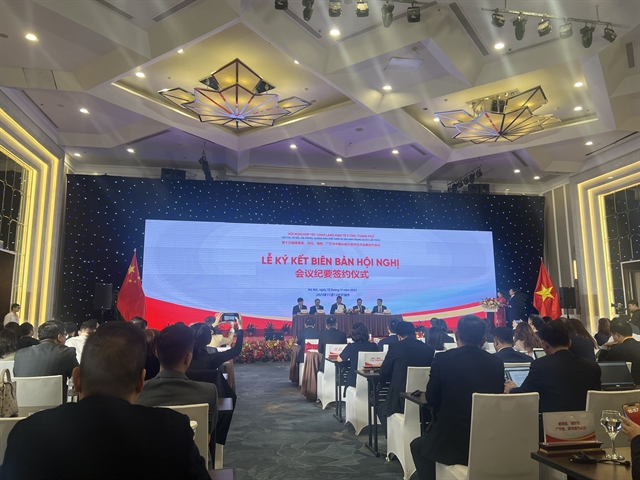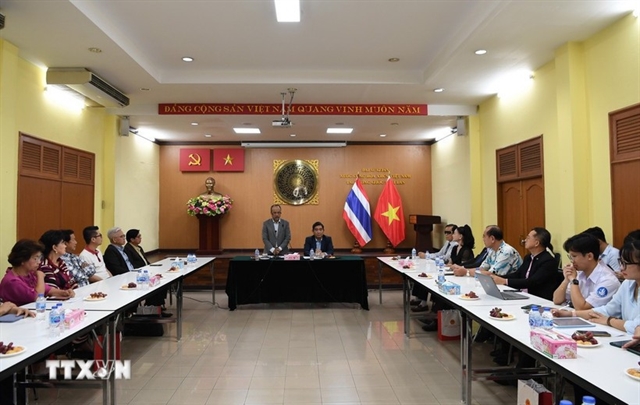 Economy
Economy

 |
| A number of cooperation agreements among those localities' authorities and enterprises were signed at the corridor's 10th cooperation conference held in Hà Nội on Monday. — VNS Photo Hoàng Hà |
by Hoàng Hà
HÀ NỘI — Việt Nam and China have great opportunities to promote cooperation along the economic corridor of four Vietnamese localities and Yunnan Province, China.
Deputy Prime Minister Trần Lưu Quang, chairman of the Việt Nam-China Bilateral Cooperation Steering Committee, made that statement at the corridor's 10th cooperation conference held in Hà Nội on Monday.
The conference attracted more than 200 delegates, including representatives of the Consulate General of Việt Nam in Yunnan’s Kunming City, the Vietnamese Foreign Ministry and Planning and Investment Ministry, the Chinese Embassy in Việt Nam, authorities of the Vietnamese localities, and many businesses.
A number of cooperation agreements among those localities' authorities and enterprises were signed at the event.
At the opening speech of the conference, Trần Sỹ Thanh, chairman of the Hà Nội People's Committee, said this was an important political and economic foreign affairs event to celebrate the 15th anniversary of establishing the Việt Nam - China Comprehensive Strategic Cooperative Partnership.
This conference also contributed to promoting cooperative development and mutual benefit between provinces and cities along the economic corridor, Thanh said.
At the conference, the Deputy Prime Minister said that cooperation between Vietnamese localities and Yunnan Province had contributed to promoting the development of supply and production chains, strengthening the connection of infrastructure, and traffic and logistics networks; and enhancing cultural, educational and tourism cooperation.
Besides highly appreciating the determination of Yunnan Province's cooperation with Vietnamese localities, especially in the fields of economics, trade, investment and tourism, the Deputy Prime Minister affirmed that Việt Nam's central-run authorities and localities had many policies to create favourable conditions for localities in the North to have sustainable development and strengthen cooperation with Chinese localities, including Yunnan.
In the future, there still are many challenges, so Quang suggested that along with focusing on promoting the efficiency of existing cooperation mechanisms, Việt Nam and China needed to jointly research to develop new cooperation models that are suitable to the potentials, advantages, conditions and development priorities of the localities of the two sides, making breakthroughs in economic, trade and investment cooperation.
The two countries needed to speed up the connection of transport infrastructure, especially roads and railways in border areas; and expand cultural and tourism cooperation, Quang said.
Chinese Ambassador to Việt Nam Xiong Bo said at the conference that the two countries would coordinate closely further to take advantage of the economic corridor cooperation for having comprehensive cooperation in all fields among the five localities.
To promote cooperation between Việt Nam and China, and among localities of the economic corridor in particular, Deputy Minister of Planning and Investment Trần Quốc Phương said that it was necessary to promote upgrading and connecting transport infrastructure between the two countries, especially infrastructure in border areas and border gates, to facilitate trade, tourism and travel of people of the two countries.
The two sides needed to create more favourable conditions for trade activities, especially agricultural, forestry and fishery products, said Phương. They also needed to promote digitalisation in the customs clearance process at the border gates of the two countries.
These localities should research and expand the scope of cooperation in the direction of connecting with major economic centres of the two countries, according to Phương.
Localities along the economic corridor should enhance organisation of investment, trade and tourism promotion programmes to support the two countries' enterprises in studying business and investment policies of Việt Nam and China.
According to Permanent Deputy Minister of Foreign Affairs, Nguyễn Minh Vũ, the economic corridor of Kunming - Lào Cai - Hà Nội - Hải Phòng - Quảng Ninh belongs to the cooperation framework "Two corridors, One economic belt" and is an inter-regional and transnational cooperation mechanism, aiming to effectively exploit the potential and advantages of localities along the economic corridor.
According to Vietnamese Consul General in Kunming, Yunnan (China) Hoàng Minh Sơn said this economic corridor is the shortest route connecting China with ASEAN countries through Hải Phòng seaport. This is also the shortest road connecting Việt Nam with the large market of southwest China's provinces such as Chongqing and Sichuan.
Therefore, taking advantage of and promoting the advantages of this economic corridor is extremely important, not only helping the economic development of each member locality, but also contributing to promoting comprehensive strategic cooperation between Việt Nam and China.
Sơn recommended that the two countries, especially localities along the economic corridor, should upgrade logistics and cold storage infrastructure, improve testing and quarantine, strengthen traffic connections, and improve transportation capacity and customs clearance in the border gate areas between Việt Nam's localities and Yunnan Province.
Founded in 2004, the economic corridor cooperation mechanism has proved effective in promoting cooperation between the four Vietnamese localities and the Chinese province of Yunnan in the fields of friendly exchanges, traffic connectivity, trade, tourism, culture and arts.
Việt Nam is the sixth largest trading partner among all countries and territories that have trade relations with China. It is China’s largest trading partner in Southeast Asia.
China is among the top 10 foreign investors in Việt Nam, with its investments spanning across various fields, from catering services, hotels, consumer goods to textiles, footwear, mineral exploitation, and industrial parks.
In 2022, Việt Nam's total import-export turnover with China reached US$175.6 billion. In the first 10 months of 2023, the turnover was $138.9 billion, down 5.88 per cent compared to the same period in 2022.
Meanwhile, up to now, China has had 4,032 investment projects in Việt Nam, with a total registered capital of over $26 billion, ranking 6th out of 144 countries and territories investing in Việt Nam. — VNS




